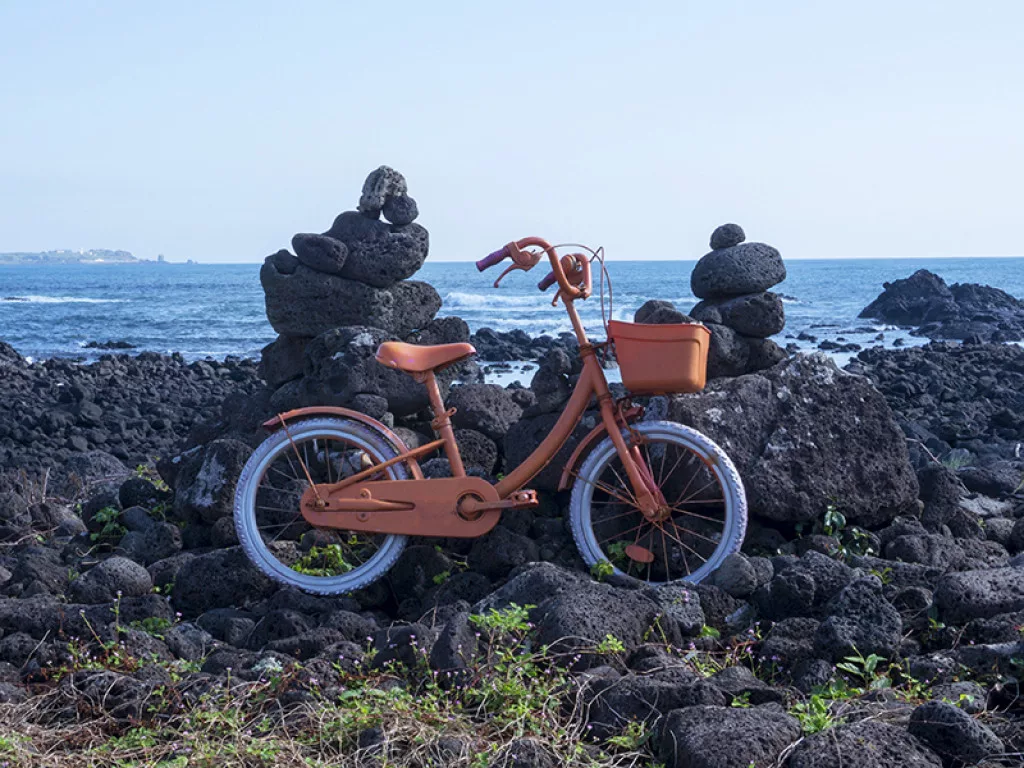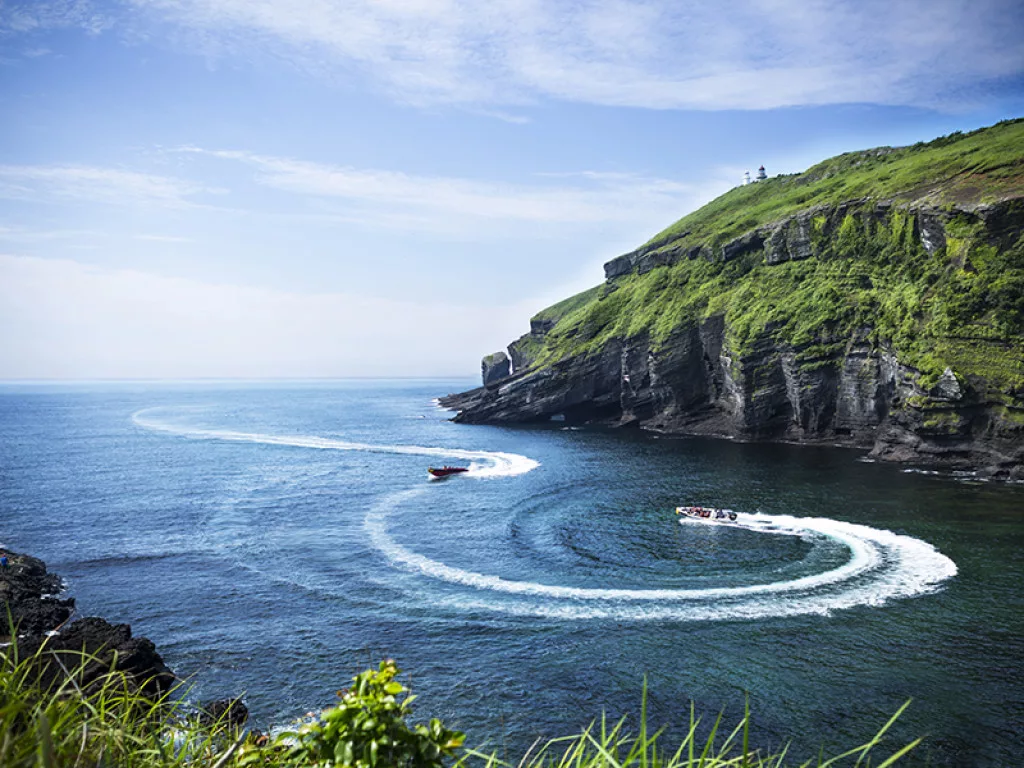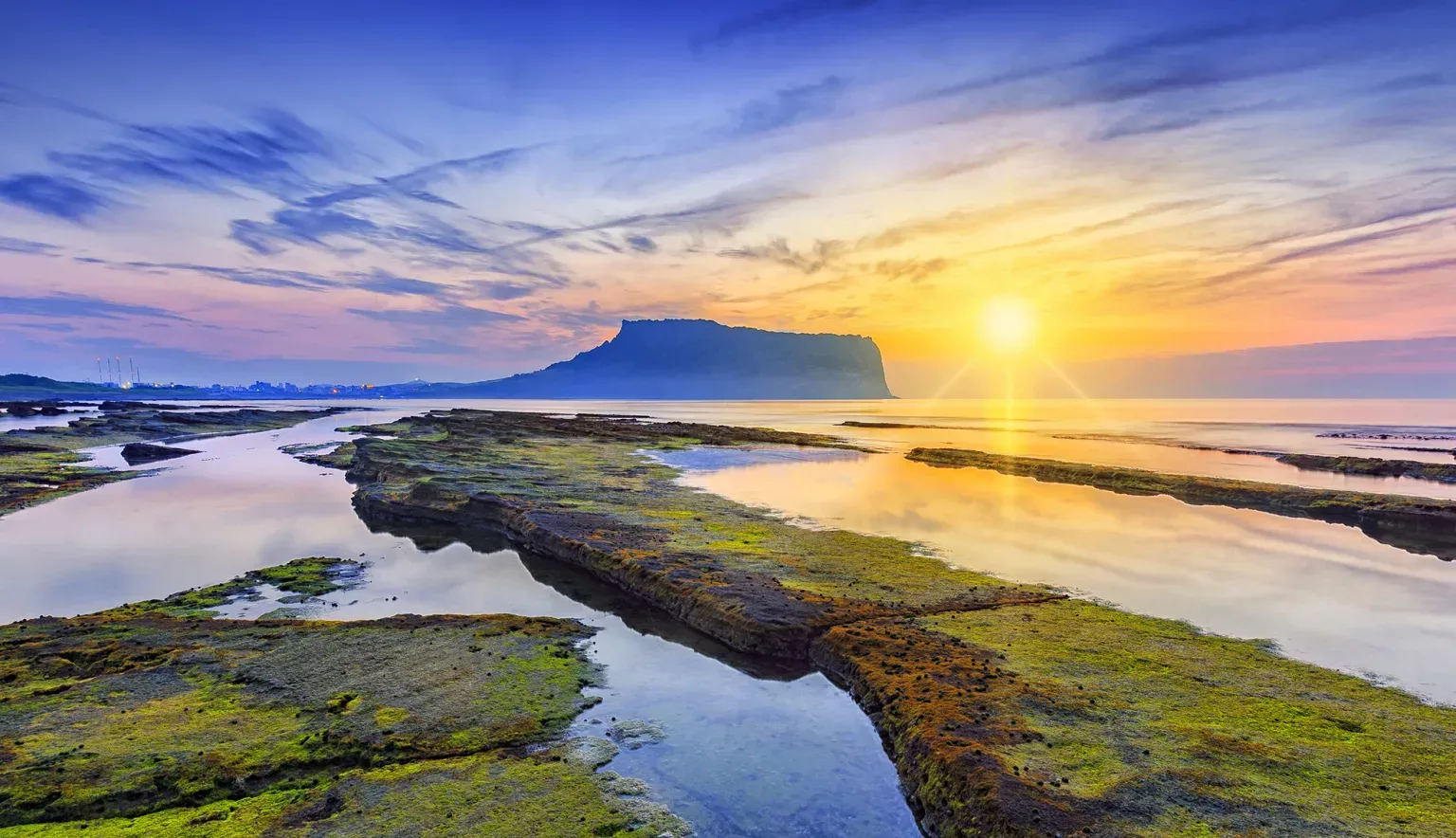The Northeast Asian Island of Jeju is an awe-inspiring land of natural wonders. The ultimate honeymoon getaway, discover South Korea’s answer to paradise.
JEJU ISLAND
‘Island of the Gods’, the volcanic land mass of Jeju, known locally as Jeju-do, has long attracted crowds of vacationers and honeymooners, and is well-established as the ideal hideaway for Korean newlyweds.
Rising up from the depths of the Korean Peninsula as Korea’s largest and southernmost island, Jeju’s serene, crater-marked landscape and mild sub-tropical climate is blessed with a natural beauty ideal for hikers and a new wave of wellness tourism.
Indeed, Jeju is officially recognised by UNESCO as a World Natural Heritage Site, Global Geopark and Biosphere Reserve, encompassing Korea’s highest peak of Hallasan Mountain, the vast forested swathes of a semi-tropical national park, a wild coastline and the world’s longest underground lava tube.
The island is known for its unique cuisine, most notably the local seafood caught by Jeju’s famous female deep-sea divers (haenyeo), all of whom are aged 60 and over. Jeju’s beaches are perfectly suited for some coastal relaxation, its idyllic waters cloaking vivid seascapes of coral. Further inland, you will find narrow lanes lined with traditional cottages rendered from the native black lava rock, while fertile volcanic soils support palm trees, flourishing mandarin groves, pineapples and exotic dragon fruit.
After arriving in the island’s main urbane hub of Jeju City, Jeju’s southern coast is the most developed for tourism. But hire a car to venture to Jeju’s more remote areas, and you will find a land that appears untouched for decades. Watch the sunrise from volcanic craters, explore towering waterfalls and unwind in a natural paradise.
“We are developing and implementing an integrated grassroots tourism brand which brings locals and visitors together”
Eun-sook Koh, CEO, Jeju Tourism Organization
TOURISM INSIGHTS: JEJU TOURISM ORGANISATION
The Jeju Tourism Organization (JTO) is the official body tasked with the promotion of tourism in Jeju. Now rising from the ashes as one of the regions hit hardest by the COVID-19 pandemic, the JTO is leading Jeju’s resurgence as an attractive destination for wellness tourism in 2022. Aside from this, the JTO is dedicated to establishing an eco-system of sustainable, resident-led tourism that flourishes in alignment with the protection of the island’s natural environment. The JTO’s CEO, Ms. Eun-sook Koh, tells us more.
Q&A WITH MS. EUN-SOOK KOH, CEO, JEJU TOURISM ORGANISATION
What role does the Jeju Tourism Organization play in tourism on Jeju Island and what public services do you offer?
Ms. Eun-sook Koh, CEO (EK): In order to help stabilise the Jeju tourism market and realise the sustainability of the local industry, the Jeju Tourism Organization (JTO) is working to improve the overall structure of the island’s brand as a global tourism destination. This involves fostering a premium tourism environment and developing customised marketing to match conditions on the ground.
The JTO provides a number of public services. These include integrated public relations marketing, product and resource development, conducting research on the tourism industry, improving preparations to receive visitors, expanding Jeju’s tourism information platform, as well as providing tourism industry training and consulting services.
How has COVID-19 affected the tourism industry in Jeju, and what do you expect for the future after the pandemic?
EK: As we’ve seen all around the globe, the tourism industry has been hit hard by the COVID-19 pandemic. Here on Jeju Island, our economy shrank by nine percent while the service productivity index dropped 13.6 percent. This is indicative of the importance of tourism to Jeju’s bottom line and thus we were among the regions hardest hit by the pandemic nationwide.
In 2019, the Jeju tourism market greeted a record 15.2 million visitors (13.5 million domestic travellers, or 88.7 percent of that total, and 1.7 million overseas visitors). The overseas tourism market was mainly focused on geographically close markets such as Japan and other countries in the region, particularly China. This obviously took a massive hit with pandemic-related restrictions on international arrivals, but we expect these numbers to recover as the world transitions to a “with COVID” era.
Why, in your opinion, should someone visit Jeju Island?
EK: Jeju has the most to offer as a holiday destination in Northeast Asia. It is Korea’s largest and southernmost island beloved for its natural beauty. Three times the size of Guam, Jeju has a mild subtropical climate and a massive national park that preserves the island’s most important (and revered) geological formation — Hallasan Mountain (1,950 metres).
UNESCO has recognised Jeju as a World Natural Heritage site and Biosphere Reserve, and more recently we gained membership in the Global Geoparks Network. Jeju is the most preferred resort and tourist destination for relaxation, healing, and affordable holidays in Korea.
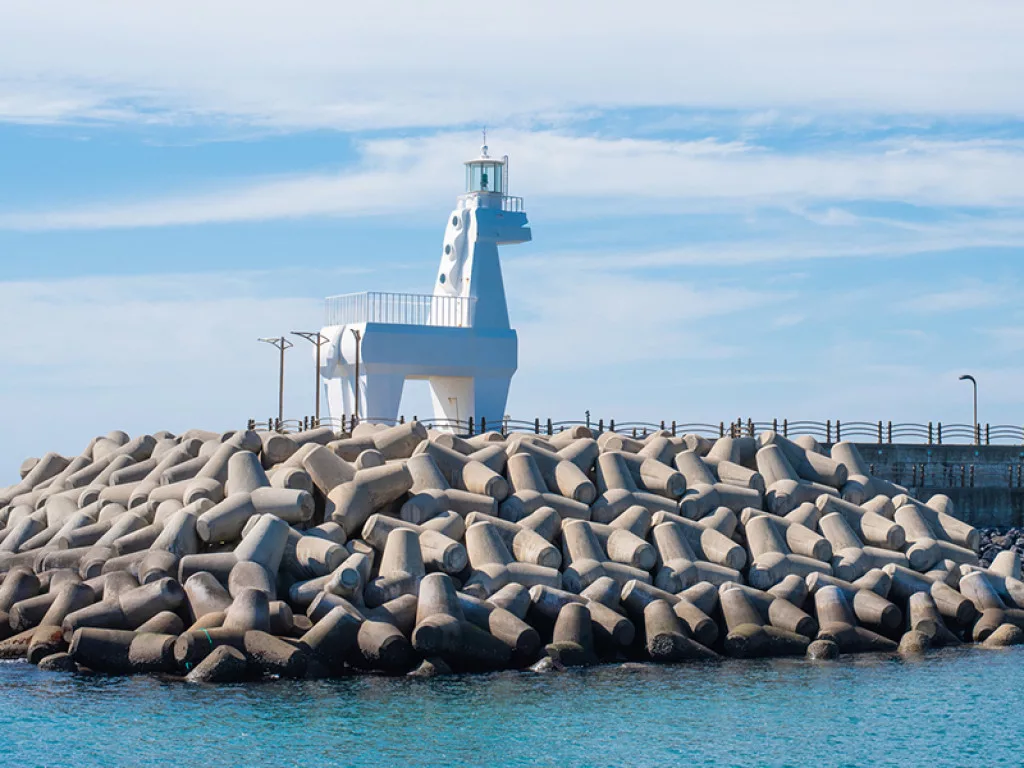
What projects are JTO developing for the tourism industry?
EK: The JTO is devoting itself to creating a sustainable, resident-led local tourism ecosystem that functions in harmony with the interests of preserving Jeju’s natural environment. We are developing and implementing an integrated grassroots tourism brand which brings locals and visitors together. The establishment of Jeju wellness tourism benefits everyone by creating jobs which put locals front-and-centre, while also exposing visitors to Jeju’s rich culture—all in a virtuous cycle of sustainability.
The JTO sees wellness tourism as an essential part of the island’s post-COVID recovery. This is a core industry that requires public-private partnerships and cooperative projects to improve local tourism at an institutional level. We are also looking at ways to cultivate new talent, create jobs, foster innovative research, and establish a range of Jeju-style wellness tourism destinations and brands. The JTO is also reaching out to international networks and embracing global standards and international certifications.
In addition, we are expanding our one-stop tourism information platform — VisitJeju.net — to provide a wide range of online tourism-oriented services. Our domestic- and international-targeted social media channels (YouTube, Facebook, Instagram, etc.) are promoting Jeju with an ever-growing archive of informative articles and videos. We are also working with a range of influencers to produce exciting new video content, as well as developing and operating a “virtual” travel programme linked with global over-the-air programming (OTA).
OUTLOOK RECOMMENDS
EAT:
For Authentic Korean Street Food…
In the bustling heart of Jeju City, Dongmun Traditional Market is the island’s largest and oldest permanent market. Here you will find a plentiful bounty of authentic Korean fare, from seafood to Jeju’s famous local mandarins. Open until midnight and located close to Jeju International Airport, be sure to stop by for some last-minute souvenirs.
For the best local delicacies…
Many first-time visitors on Jeju come in search of the island’s delicious black pork. The meat tastes even better if you eat it with Mel-jeot, which is a salted anchovy that reduces the pork’s oiliness and makes it tastier. For seafood, Jeon-bok (abalone) is so nutritious that it is also known as the wild ginseng of the sea. Many abalones are gathered from Jeju waters and it can be found in many delicacies. It is usually prepared as porridge and various other stews.
DO:
For exploring the island on foot…
As Korea’s national pastime, you would be amiss to visit Jeju without going hiking. The Olle coastal trails circle most of the island and are a fantastic way to explore Jeju’s rugged coastline with long distance routes or easily navigable shorter sections. Home Comforts Hiking offer a fantastic selection of guided hiking tours that can be booked through their website.
For an unforgettable sunrise…
Seongsan Ilchulbong, otherwise known as ‘Sunrise Peak’, is the best spot to observe Jeju’s breath-taking sunrises. Located on Jeju’s eastern side, the peak enjoys the earliest dawn and even hosts a sunrise festival every New Year’s Eve. A hike to the summit should take no longer than 45 minutes along a paved, albeit steep, stepped path.
SLEEP:
For a first-class resort…
Found in the Jungmun resort area of southwestern Jeju, The Shilla Jeju boasts ultimate comfort with all the amenities for a relaxing stay, including immediate beach access and sophisticated modern décor. From some rooms, you can even enjoy views of Hallasan Mountain towering in the distance.
For a peaceful temple stay…
Temple stays offer a fantastic traditional experience in Jeju for those willing to go without Western amenities. Enjoy meditation, grounds-sweeping and tea ceremonies. However, be warned since most stays typically include a pre-dawn wake up call! Visit eng.templestay.com for English-speaking options.
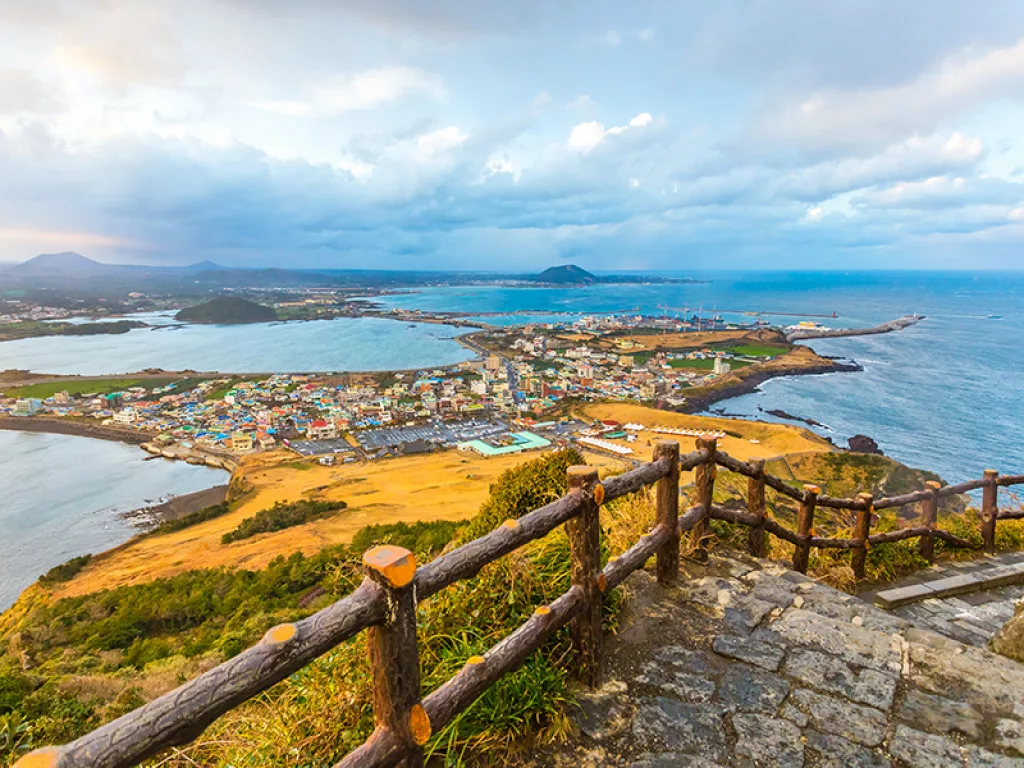
SEOGWIPO IN FOCUS
Jeju hosts two regional cities; Jeju City, and the southern hub of Seogwipo. Seogwipo offers a quieter, more secluded alternative to Jeju City and is the perfect gateway to exploring the volcanic southern coast. The city is easily covered on foot, with downtown Seogwipo hosting the traditional Olle Market.
Seogwipo is surrounded by lush gardens and citrus farms bordered with fences made from the local black rock. Nearby attractions include the Jeongbang Falls, as the only waterfall in Asia that pours directly into the ocean. Similarly, Cheonjiyeon Pokpo is another jaw-dropping waterfall that can be reached by a short hike through a scenic forested gorge. Both falls can be found on the Olle Trail Six, or by taking a city tour bus from central Seogwipo.
Blessed with clear waters and mild ocean temperatures, Jeju’s second-largest city is also popular for its scuba-diving opportunities, boat trips and submarine tours.
The Mermaids of Jeju
Alongside the Jungmun Resort area, Seogwipo is one of the best places to observe the iconic deep-sea divers of Jeju at work. Otherwise known as haenyeo, these free divers are all aged 60 plus, with a minority still diving well into their eighties, and are an iconic and unique feature of Jeju’s cultural history.
Women began diving off the island for food when Jeju’s menfolk would disappear for weeks at a time on fishing boats. Without the use of any breathing apparatus, haenyeo continue to dive to depths of between 10 and 20 metres in wetsuits searching for the likes of octopus, abalone, clams and seaweed. This seafood provides an essential food source, particularly since the Asian staple of rice is unable to grow on Jeju’s wild and windy shores.
Although the haenyeo are a rarer phenomenon today, they remain a source of renown throughout the country.
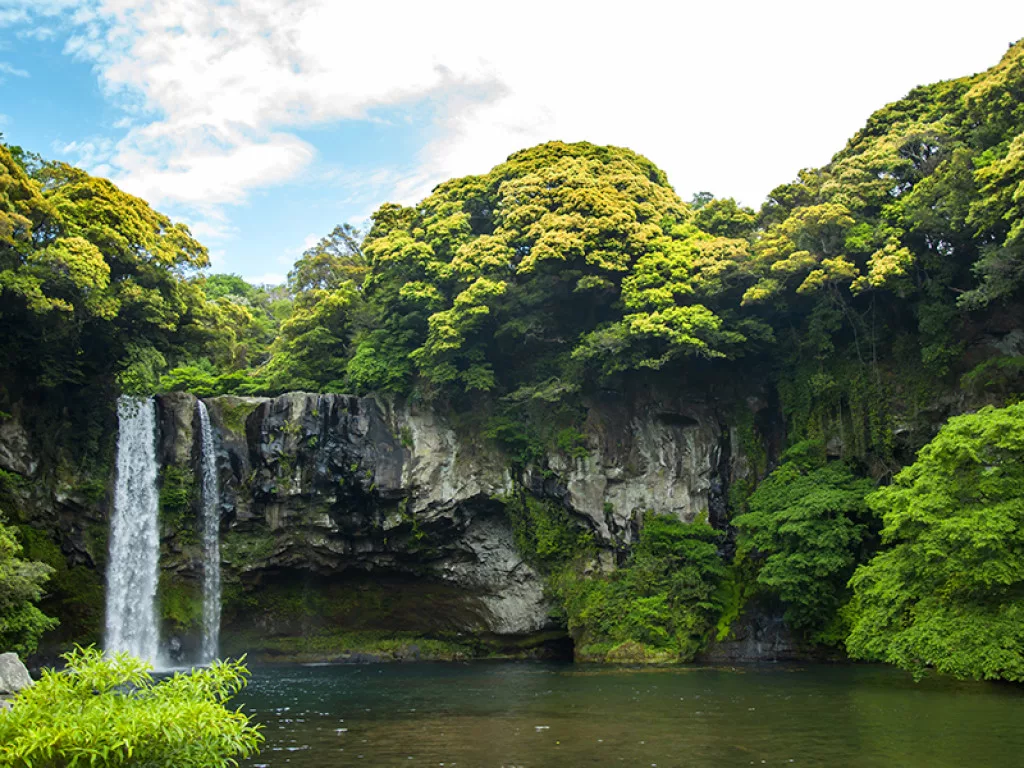
LANDMARK ATTRACTIONS
Grandfather Stones
The distinctive ‘grandfather stones’ of Jeju are manmade landmarks hewn from pillars of black rock by local masons over the centuries. 45 original statues still exist across the island and are Jeju’s equivalent of the iconic Easter Island moai. Phallic in appearance, legend has it that the stones were originally constructed as harbingers of fertility.
Hallasan Mountain
The dormant volcano of Hallasan towers at a height of 1,950 metres above sea level and represents a challenging feat for keen hikers looking for a rewarding day’s climb. This UNESCO Biosphere Reserve comprises a crater lake, alpine plants and local wildlife including woodpeckers, chipmunks and butterflies. In spring, the mountain is particularly picturesque, carpeted in pink azaleas.
Manjanggul Lava Tubes
A UNESCO World Natural Heritage site, the Manjanggul Lava Tubes are the gateway to the longest underground lava tube in the world. Formed from cooled volcanic lava, the network stretches five miles underground and offers a fantastic subterranean glimpse of stalactites, stalagmites, cave coral and lava bridges.
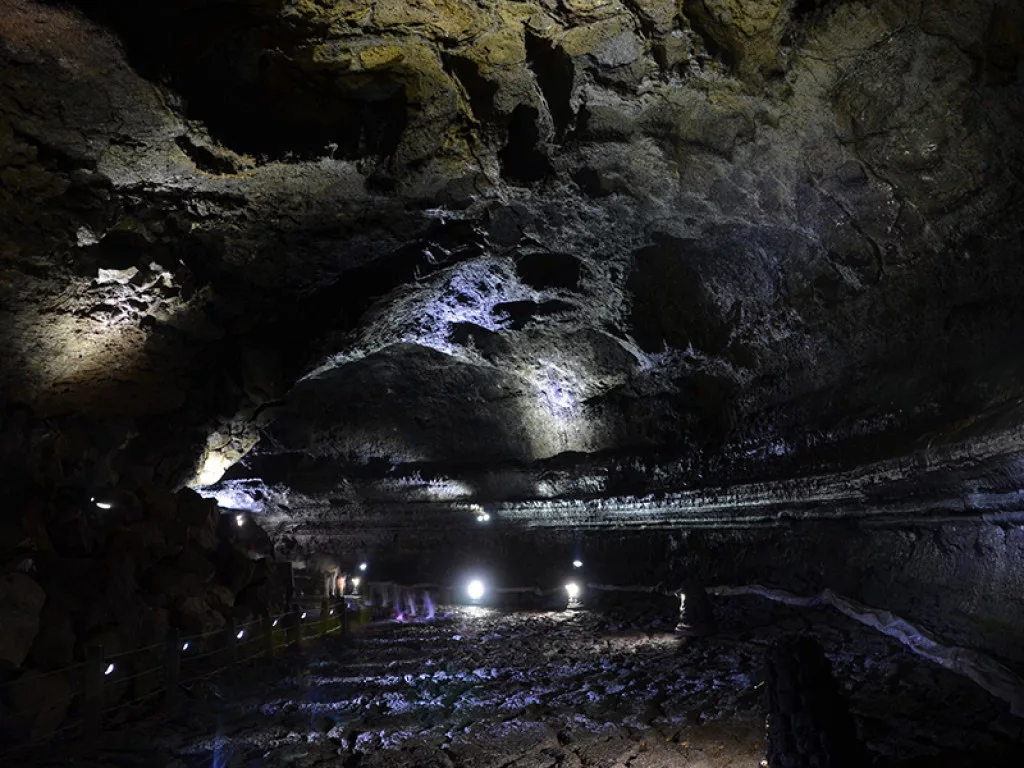
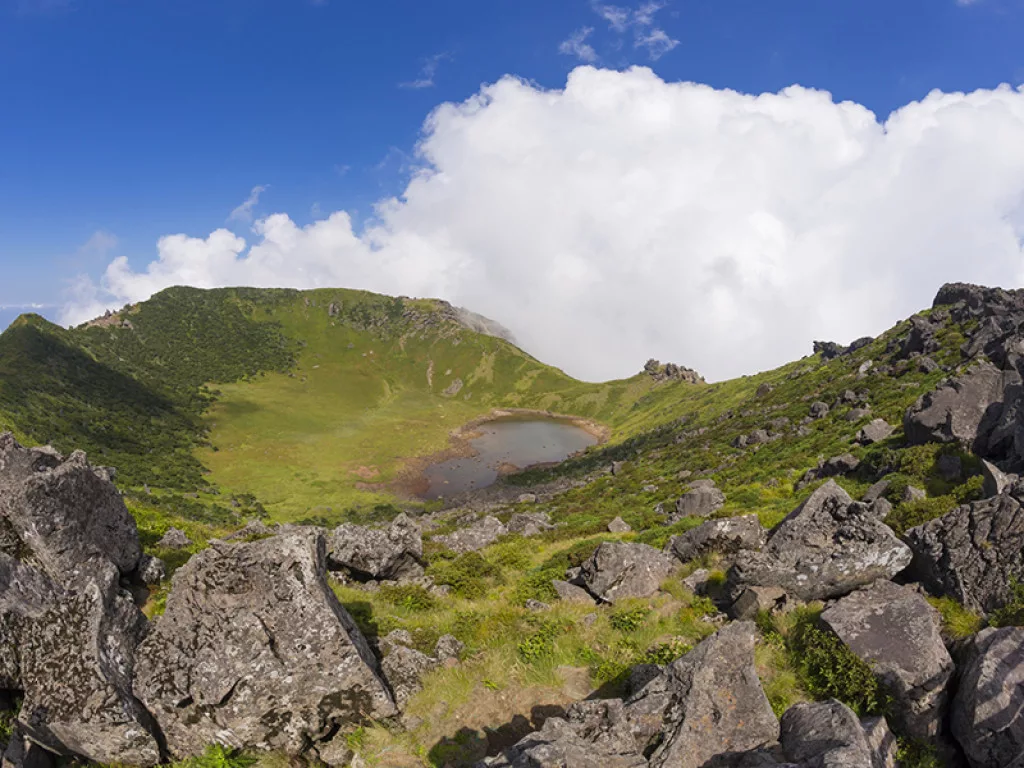
GETTING THERE AND AROUND
At less than 70 kilometres long, travel times for traversing Jeju can still be long, particularly if travelling by bus. Renting a car is a popular choice of transport for getting around Jeju, with bike rentals available in many smaller locations. Longer distance bike trips are a great way to explore the perimeters of the island, along mainly empty scenic roads. Allowing four to five days to complete the full circuit, keen cyclists may choose to plan a trip taking in overnight stops in booked Airbnb rooms along the way.
Buses and taxis are the main source of public transport in the metropolitan areas of Jeju City and Seogwipo. Arriving into Jeju City, the island is easily accessed with regular direct flights from international cities including Shanghai, Beijing, Tokyo and Osaka, as well as South Korea’s domestic airports.
